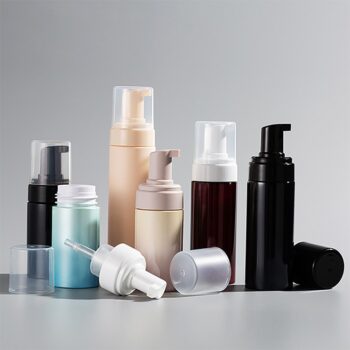In the packaging of cosmetics and skin care products, pump bottles are a common and practical design. Pump bottles are not only easy to use, but also effectively prevent product contamination. However, it is essential to properly lock the pump bottle and ensure its safety. This article will detail how to lock the pump bottle and the various methods and considerations to ensure the safety of the pump bottle.
First, the basic structure of the pump bottle Pump bottle usually consists of the following parts:
- Pump head: used to press out liquid.
- Pump tube: Connect the pump head and the bottom of the bottle for drawing liquid.
- Bottle body: container for storing liquid.
- Sealing ring: the key component to prevent liquid leakage.
Understanding the basic structure of the pump bottle helps us better grasp how to lock the pump bottle and ensure its safety.
Second, how to lock the pump bottle
The steps to lock the pump bottle are as follows:
1, press the pump head: First press the pump head in the end, then part of the liquid will flow out. The purpose of pressing the pump head is to keep the pump head in the lowest position for subsequent locking operations.
- Rotate the pump head: Keep the state of the pump head pressed, rotate the pump head more than 90 degrees clockwise, or twist several turns until the pump head is locked and no longer springs up. Locking the pump head prevents the pump head from accidentally pressing during transportation or storage, resulting in liquid leakage.
Measures to ensure the safety of pump bottles
- Check the tightness: the tightness of the pump bottle is the key to ensure its safety. Before use, check whether the seal ring of the pump bottle is intact to ensure that there are no cracks or wear. The role of the seal ring is to prevent the leakage of liquid from the pump bottle, so its integrity is crucial.
- Use a leak-proof design: Choosing a pump bottle with a leak-proof design can greatly reduce the risk of liquid leakage. Leak-proof designs usually include double sealing rings, special pump head designs, etc. These designs prevent liquid leakage even when the pump bottle is subjected to external forces.
- Regular inspection: Regularly check the pump head and seal ring of the pump bottle to ensure that there is no wear or damage. The pump head and seal ring are the key parts of the pump bottle, and their status directly affects the use effect and safety of the pump bottle. Regular inspection can detect problems in time to avoid liquid leakage or pump bottle failure.
- Correct storage: Pump bottles should be stored in a cool, dry place, avoid high temperature and direct sunlight. High temperature and direct sunlight will accelerate the aging of the pump bottle material, resulting in the failure of the seal ring or the deformation of the pump head, thus affecting the use of the pump bottle effect and safety.
- Avoid excessive pressure: When using the pump bottle, avoid excessive pressure on the pump head. Excessive pressure will increase the wear of the pump head and seal ring and shorten the service life of the pump bottle. In addition, excessive pressure may also cause liquid to splash, resulting in waste.
Fourth pump bottle locking and security in practical applications
The locking and safety of the pump bottle is not only related to the use of the product, but also related to the consumer experience. For example, in the cosmetics industry, the locking and security of the pump bottle directly affects the portability and ease of use of the product. A well-designed pump bottle allows consumers to safely carry the product in their bag without having to worry about liquid leaks when traveling or going out.
Fifth. Future developments in pump bottle locking and security
With the advancement of technology, the locking and safety design of the pump bottle is also constantly evolving. In the future, the pump bottle may adopt more intelligent design, such as automatic locking function, intelligent seal detection and so on. These designs will further improve the convenience and safety of the pump bottle, providing a better user experience for consumers. In addition, the application of environmentally friendly materials is also an important direction for the future development of pump bottles. Traditional pump bottles mostly use plastic materials, although the cost is low, but caused a greater burden on the environment. In the future, pump bottles may be made more of degradable or recyclable materials to reduce environmental impact.
Page six: Conclusion
Pump bottle as a common packaging design, its locking and security directly affect the use of products and consumer experience. The safety of the pump bottle can be effectively ensured by properly locking the pump bottle, checking the tightness, using a leak-proof design, regular inspection and proper storage. In addition, with the advancement of technology and the improvement of environmental awareness, the locking and security design of the pump bottle will continue to evolve, providing consumers with a better use experience. Hopefully this article will help you better understand the locking and safety of pump bottles. If you have any questions or need further assistance, please feel free to contact me.




